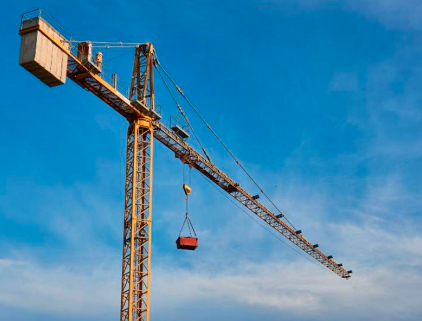Ultimate Guide to Understanding Crane Wind Speed Limit

The crane wind speed limit is one of the most critical factors in maintaining safety and stability during lifting operations. Strong winds can dramatically affect a crane’s balance, control, and load capacity, making it essential for operators to understand when conditions become unsafe. In this ultimate guide, we’ll break down everything you need to know about the crane wind speed limit, from how it’s determined to the best practices for monitoring wind conditions and preventing accidents on-site.
The Risks Wind Poses to Crane Operations:
Wind creates serious hazards for crane operations because it can push against both the crane and its load. This can cause:
- Load Sway and Loss of Control – The load can swing uncontrollably, increasing the risk of collisions or accidents.
- Crane Tipping – Strong wind can shift the crane’s balance, especially with long booms or heavy loads, leading to tipping.
- Structural Stress or Failure – Wind can overstress the boom, cables, joints, or other components, potentially causing breaks or collapse.
- Increased Danger at Height – Wind is stronger at higher elevations, making tall cranes more vulnerable.
- Operational Delays and Safety Risks – Uncontrolled loads or crane instability endanger personnel and can halt work.
Always follow manufacturer wind limits, use wind monitoring tools, plan lifts carefully, and adjust the crane or load when winds are strong.
General Wind Speed Guidelines
- Safe Range (0–12 mph / 0–19 kph)
- Conditions: Winds are light and generally do not affect crane stability.
- Operations: Normal lifting operations can proceed without special precautions.
- Risks: Minimal; there is a low likelihood of load sway, boom deflection, or instability.
- Notes: Operators should still monitor conditions, but standard operating procedures are usually sufficient.
- Caution Range (13–31 mph / 20–50 kph)
- Conditions: Moderate winds begin to exert noticeable force on both the crane and the suspended load.
- Operations: Operators should reassess the lift plan, considering:
- Load size and shape: Larger or flat-surfaced loads catch more wind, increasing sway.
- Boom length and height: Longer and higher booms experience more wind pressure, affecting stability.
- Site conditions: Open areas, nearby structures, or gusty winds can increase risks.
- Actions: Adjust lift procedures if necessary, reduce load size, shorten boom extension, or delay the lift until wind conditions improve.
- Risks: Load may sway more than normal, and crane stability can be affected if adjustments are not made.
- Stop Range (32+ mph / 51+ kph)
- Conditions: Strong winds create unsafe conditions for any lifting operation.
- Operations: All lifting must stop immediately.
- Risks:
- Crane tipping due to loss of balance.
- Uncontrolled load swing that can endanger personnel and equipment.
- Potential structural stress or failure of booms, cables, and other crane components.
- Notes: Resume operations only when wind speeds fall below the safe or caution ranges and after reassessing conditions.
These wind ranges give a basic guide for safe crane operation. Always follow the crane manufacturer’s limits and your site’s safety rules.
Factors That Influence Wind Limits
Several key factors determine how wind affects crane safety:
- Load Surface Area – The size and shape of a load affect how much wind it catches. Larger or flat loads catch more wind, which can make them sway or rotate, increasing the risk during lifting operations.
- Lift Height – Wind gets stronger the higher you go. Taller lifts are more affected by wind, so they need lower wind limits to stay safe.
- Crane Type and Configuration – Different cranes respond differently to wind; for example:
- Tower cranes and luffing jib cranes are tall and slender, prone to sway.
- Mobile cranes’ limits depend on boom length, extension, and counterweights.
- Site-Specific Conditions – Things around the site, like buildings, valleys, cliffs, or the coast, can change how the wind blows and cause sudden gusts or strong wind channels. It’s important to measure the wind at the crane itself to make sure lifting is safe.
Wind speed limits depend on load size, lift height, crane type, and local site conditions. Considering these factors ensures safe crane operations.
Crane-Specific Wind Speed Limits
- Tower Cranes
- Operational limit: Stop lifting if winds exceed 38–45 mph (61–72 kph).
- Idle mode: Allow the crane to weather vane (rotate freely with the wind) to prevent structural stress.
- Mobile Cranes
- Operational limit: Lifting usually stops at 22 mph (35 kph).
- Notes: Lower limits may apply depending on boom length and load surface area.
- Crawler Cranes
- Operational limit: Stop operations around 26.8 mph (43 kph).
- Reason: Large surface area makes them sensitive to wind gusts despite a stable base.
- Overhead and Gantry Cranes
- Indoor overhead cranes: Wind is typically not a concern.
- Outdoor gantry cranes: Follow site-specific guidelines, usually stopping at 20–25 mph (32–40 kph).
- Floating/Marine Cranes
- Operational limit: Lifting often stops at 20 mph (32 kph), especially in rough seas.
- Reason: Operating on water adds instability.
- Telescopic Boom Cranes
- Operational limit: Stop lifting at 20–25 mph (32–40 kph).
- Reason: Highly susceptible to wind, especially with extended booms.
- Luffing Jib Cranes
- Operational limit: Stop at around 38 mph (61 kph).
- Notes: Like tower cranes, use weather-vaning when idle to maintain stability.
- Self-Erecting Cranes
- Operational limit: Secure or lower the crane at around 25 mph (40 kph).
- Reason: Smaller, lighter cranes are more vulnerable to wind.
Each crane type has specific wind limits based on design, stability, and operating environment. Exceeding wind limits can cause accidents, so operators must monitor wind and follow all safety guidelines.
Monitoring Wind Conditions
Proper monitoring of wind is essential to maintain crane stability and safety. Continuous observation allows operators to adjust or stop lifts immediately if wind speeds approach unsafe levels.
Tools for Measuring Wind
- Cup Anemometers: Reliable for general wind speed measurements.
- Hotwire Anemometers: Sensitive to small changes in airflow.
- Vane Anemometers: Measure both wind speed and direction, helping crane operators make accurate and safe adjustments.
Measuring at Crane Height
- Wind is often stronger and more variable at lift height than at ground level.
- On-site measurements provide accurate, real-time data.
- Relying solely on general forecasts can underestimate gusts and risk.
Always monitor wind continuously at the crane’s working height using appropriate tools to ensure safe, controlled lifting operations.
Best Practices for Crane Safety in Windy Conditions
- Pre-Lift Planning
- Check both short-term and long-term weather forecasts before starting any lift.
- Schedule lifts during calmer periods whenever possible.
- Prepare contingency plans in case wind speeds increase suddenly.
- Real-Time Monitoring
- Use on-site anemometers to track live wind data at crane height.
- Real-time readings allow teams to make timely decisions to pause or adjust lifts.
- Crew Communication
- Maintain clear communication among all personnel.
- Follow standard wind alert protocols and ensure the crew is trained to recognize unsafe conditions.
- Real-time alerts (auditory or visual) help teams respond quickly when wind speeds rise.
- Decision Authority
- Crane operators should have full authority to stop operations immediately if conditions become unsafe.
- Empowering operators ensures faster reactions to sudden weather changes.
Planning, monitoring wind, clear communication, and empowering operators keep crane operations safe in windy conditions. These steps are best practices and also follow OSHA safety rules.




